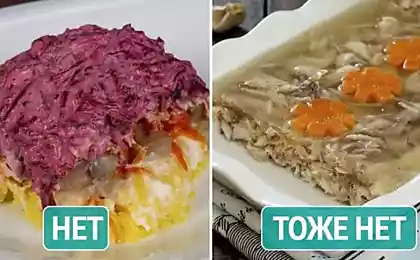854
Regular meals (16 pics + text)
In this post we ozankomilis with a small, but nevertheless rated, alcoholic drinks made from grain.
It also rightly YaPovets TomTiT asked, they say, but where are the snacks? ..
I scratched turnip and decided that the question of appropriate and shamefully forgotten.
Opened notebook, ran through contacts ICQ with the question: "What is the appetizer right?" And of the resulting responses made rated Proper Snacks (I really do not know why, but it seems all the respondents the word "snack" was associated with the word "vodka", here are the answers )
Well, it turned out - to judge you.
So there you go.
Meet:
Rating the most correct snacks.

1 place.
Salted cucumbers.
Dish, cucumber prigotavlyaemoe by salting, often with the addition of spices rznoobraznyh.
Pickles - one of the main dishes of Russian cuisine.
Preparation is the cucumbers are placed in brine.
In addition to the salt in the brine add spices, which vary depending on the recipe: garlic, dill, pepper, blackcurrant leaves or oak, horseradish and other.
Cucumbers, which only had prosolitsya called salted.

2nd place.
Salo.
"Lard contains arachidonic acid, which is one of the essential fatty acids. As a result the biological activity of fat is 5 times higher than that of butter ».
The true birthplace of fat is not Ukraine, and even Russia (well, at least not yet, scientists have not found the type Chudinov fat recipes from the Triceratops, written in Cyrillic still in the Mesozoic).
Homeland fat correctly as Italy. It was there three thousand years ago there was an idea to use lard as a cheap and high-calorie food for the slaves who worked in the marble quarries.
People of the Middle Ages were eating bacon in large quantities.
Sam St. Benedict, the founder of the Benedictine monks allowed to have fat. The monks said that "fat pig as related to each other as the vine and the wine."
Salo is not only ate - in the Middle Ages also made of a candle.
Today fat is indispensable in variety sketches and miniatures on Ukrainian themes.
Well, think for yourself, if not fat, what would be even comedians joked about the Ukrainians?

3rd place.
Sauerkraut with cranberries and apples.
Sauerkraut mixed with cranberries, apple slices, green onions, sugar, seasoned with vegetable oil.
Instead of apples, you can add pickled or marinated vegetables.
Since ancient times - it is the Russian snack, as well as an inexhaustible source of vitamins.

4th place.
Aspic with horseradish.
The true king of Russian zatolya. Basically it is a dish called the jelly in the western regions of Russia, while the Urals and further to the east, the dish is called jelly.
Also, sometimes called the "Jelly" is applied to the dish prepared from pork or pork-beef broth, to distinguish it from dishes prepared exclusively from beef broth.
Ideally, the jelly is made from cow's head, brain, and all four legs, however, it is permissible to use only their feet, adding pieces of meat, tails and so on. N. If we are talking about the use in jelly pork, the good use of pig ears tails, legs.
In general, for jelly to be used those parts of the carcass, which is sufficient gelling agents.
There are national variations jelly, for example, Georgian dish muzhuzhi, Moldovan Jelly Cock, and so on. D.
Curiously, from the German word Sulze (jelly) occurs Russian "Brawn" is not related to jelly and is a separate dish.
The indispensable starter for the true connoisseurs, emphasizes the taste of vodka.

5th place.
Potato.
Homeland potatoes are South America, where the crop was grown from time immemorial.
For the first time the potato was described in the book of the XVI century Spanish "Chronicle of Peru" and is called "a special kind of peanut-covered skin, like truffles." It seems to be delicious and satisfying overseas "nut" was destined by fate once won wide popularity in the new territories. But nothing of the kind, alas, did not happen - the Europeans initially embraced a bizarre vegetable hostility and even declared toxic.
And in Russia (here the potato was introduced only when Peter I) peasants and did dubbed it "the devil's apple" and flatly refused to grow Ferris seed, then to not "burn in hell for this."
Interestingly, in Russia we tasted and appreciated the potatoes until the end
XVIII century, and it began to call her only as "benefactor" and "second bread».
In public documents of the time it stated that "particularly help the starving earthen apples, koi in England called poteytes, as in other places - Jerusalem artichoke, and tortufelyami kartufelyami».
Few know that the potato diet is prescribed for diseases of the joints, and anemia, and potato juice treat stomach ulcers
and scurvy. Couples boiled potatoes "in uniform" is recommended to breathe in respiratory diseases, and baked potatoes are especially useful for those who suffer from cardiovascular illnesses.
Well, as an appetizer ...
I think you know.

6th place.
Sandwich (with sausage or cheese or both).
The dish consists of a slice of bread, which put additional food (but not necessarily the oil).
There are many types of sandwiches - from the classic butter, sausage or cheese to the multilayered creations from a variety of meats, vegetables, herbs and exquisite sauces.
The most common type sandwiches - a slice of bread with some fast food (cheese, ham, sausage, eggs, meat, fish, canned food).
Sandwiches should be beautiful and appetizing appearance, a pleasant aroma and delicious taste.
You can arrange them in foil and spicy vegetables, eggs and lemon slices, olives, sauces, mayonnaise with gherkins and others. Sandwiches served on dishes, vases with flat edges or on plates covered with napkins. Sandwiches are not subject to long-term storage, so they are prepared for an hour or two before serving.
Almost always falls buttered side facing down.
"Fast" snack.

7th place.
Pickled mushrooms.
About mushrooms people knew already in the distant past. In the IV century BC Greek scholar Theophrastus mentioned in his writings about the truffles, morels, mushrooms.
After 5 centuries, the Roman naturalist Pliny also wrote about mushrooms. He first tried to divide the mushrooms on useful and harmful. The ancient Romans knew very well what harm can bring poisonous mushrooms. Sometimes, when it was necessary to remove objectionable statesman in ancient Rome served him a dish, liberally seasoned with poisonous mushrooms.
Mushrooms - amazing creatures. They have no roots or leaves, blossom and they do not provide common fruits with seeds. They multiply disputes, which are those mushrooms that we break away from the tree-mycelium, which is located under the ground.
Fresh mushrooms contain a significant amount of water, an average of 90%. In the heat treatment, the amount of water is reduced by almost half, while drying reduced to a minimum.
As they contain nutritional mushrooms surpass many vegetables and fruits, and chemical composition and number of features closer to the products of animal origin.
Pickling fungi - a way blanks with acetic or citric acid, spices, salts and sugars.
And of course it is "fast" because of the rapid snack serving by opening banks and die and fall to the contents of the plate.

8th place.
Herring on rye bread.
Almost - Russian land.
Once the question - what to feed the Germans to prevent hunger, Bismarck allegedly replied: herring - delicious, healthy and economical products.
It is now difficult to say whether it's true or fiction.
Anyway, after some enterprising fishermen patented name of marinated herring - Schlosskase Bismarck - and amassed her fortune.
The result of emigration of herring in conjunction with the Russian Borodino bread you can see themselves suddenly almost every organized "nezhdanchik."

9th place.
Butrebrody with red caviar.
This native Russian products used from time immemorial.
Mistakenly believe that in the old days it was served only in the houses of wealthy people.
Red caviar is a favorite national product, which has passed in the history of the royal feasts up to modern techniques.
Red caviar is extracted from the valuable species of salmonids and varies according to the method of preparation and taste palette is striking in its diversity: chinook, sockeye, pink salmon, chum salmon, trout, coho, salmon.
In view of inflated prices for everyday drinking bouts it is not used.
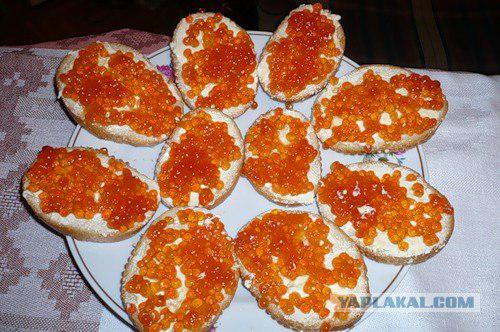
10th place.
Salted tomatoes.
Many will not tell, the principle is the same as that of the cucumber, it is also considered a traditional snack, too, are salted, and also as the cucumber is one of the appetizers to the main Russian spree.
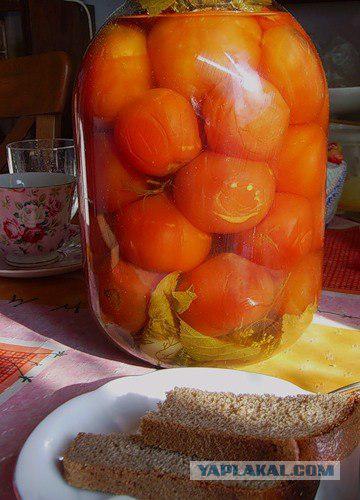
11th place.
Barbecue.
Skewer (or shish-kebab) - a dish of many nations of Asia, which is unparalleled in the ancient world. Traditionally made with lamb, roasted on skewers (metal or wooden rods). Meals are cooked on a spit traditional for many peoples of the world and go back to prehistoric times.
In the second half of the XX century it has become a cult dish in the USSR and spread to other countries (especially, he became popular for picnics.
All the increasingly popular variety of meat roasting on coals not on skewers, on the grill and under the umbrella term barbecue.
This multitude of formulations: for example, in addition to the traditional lamb was used pork, chicken and turkeys, as well as fish. Pezhe used beef.
Moving from lamb to pork as the main raw material for the barbecue it was caused by several reasons: firstly, the lamb has quite a strong specific smell (and taste), which is not to everyone's taste; Second, the pork is much more accessible, as is done in much larger quantities.
Also made of salmon, shrimp tempura, fillet of poultry and vegetarian.
Excellent snack under a lot of vodka.

12th place.
Ear fishing.
Ear, prepared according to certain prevailing regulations concerning the selection of fish, the amount and composition of vegetables and spices, the order of bookmarks, and cooking time.
Fish soup cooked only from fresh fish and nature, preferably at the stake.
If you cook at home from frozen fish, she was also very edible, but do not call it fishing.
Total business rule must be observed strictly: the larger the fish, the less spices - the sweeter, more aromatic ear.
Then the ear will have a taste and smell of natural river fish, not the bay leaf and parsley.
The bowler is allowed to put a few petals sorrel or a slice of lemon.
Once the pot is removed from the heat, it should be wrapped in a jacket for 10-15 minutes to ear uprela.
Fisherman's ear usually drink from mugs, seizing boiled fish.
Cooking soup finished pouring into the pot a glass of vodka and lowering it smoldering golovёshki.
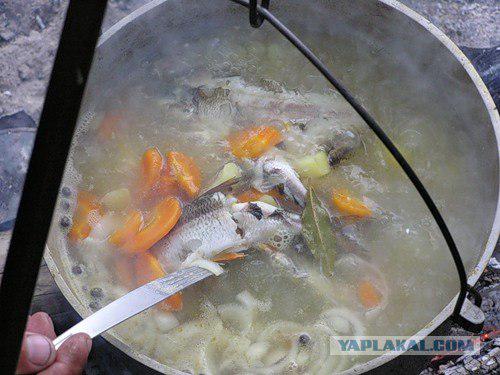
13th place.
Borsch.
The classic dish of beet used in the Slavic countries, the countries of eastern and central Europe, in particular Russia, Ukraine, Poland (Polish. Barszcz), Belarus, Romania (rom. Borş), Moldova, Lithuania (LTL. Barščiai).
In the West, better known name "borscht» (Borscht), came from Yiddish. Beet borscht gives the characteristic red color.
According to connoisseurs of vodka, it is the only correct "hot" snack.

14th place.
Beer (yes, oddly enough, but some believe the beer snack).
The alcoholic drink obtained malt alcoholic fermentation of beer wort by yeast, typically with the addition of hops.
The ancient drink known in Ancient Egypt (wheat and barley, the people there began to cultivate exclusively for beer and bread making was just a side effect).
Beer is usually produced in the northern regions, where the climatic conditions are not allowed to grow grapes.
In the Middle Ages it was considered a drink of the poor, it had a lower status than wine.
The winemakers, naturally, opposed the construction of breweries and sought to maintain the prestige of their products. Already in the 1782-86 biennium. Paris wine consumed 14 times more than the beer.
Many brewers had to deal with more and producing cider, not to be left at a loss, because in times of economic growth of their consumers invariably passed on wine.
There are many varieties that vary according to the method of fermentation (ale, lager, lambic, unfiltered, and so on. D.), In color, in sones (instead of malt used neproroschennye wheat, rice, corn, and so on. P.) And the fortress. < br /> Perfect "grinding" with the lack of a degree followed, known to all, the effects of the morning.

And finally, last,
15th place.
Olivier Basin.
(yes, you read that right, it is a basin).
Salad "Olivier" was invented in the 60s of the XIX century French chef Lucien Olivier - the owner of the restaurant "Hermitage", which in those days was at the Pipe Square. By all accounts it was not a restaurant, but most vysokorazryadny Parisian restaurant.
The main attraction of the Hermitage Kitchen immediately became a salad "Olivier».
How to prepare salad Lucien Olivier kept secret and his death a secret recipe was considered lost. Nevertheless, the basic ingredients were known in 1904 cooking salad recipe was reproduced.
That's part of it; 2 grouse, veal tongue, a quarter pound of pressed caviar, half-pound of fresh lettuce, 25 pieces of boiled crayfish, half a tin of pickles, half a tin of soy Kabul two fresh cucumber, a quarter pound of capers, 5 hard-boiled eggs. For the sauce: mayonnaise mayonnaise should be prepared in French vinegar of 2 eggs and 1 pound of olive (olive) oil, however, in the opinion of experts, it was not. But try to cook.
"Length" of a snack - you can have a few days without being distracted by other cooking snacks.
Salad, without which imagine any holiday.
Also it went down in history as the best "pillow drunk».
Thanks:
Wikipedia, numerous sites with recipes, as well as Yandex Photography.
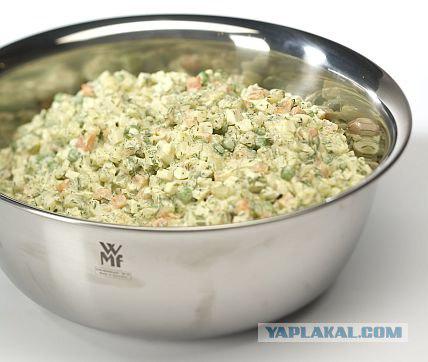
Source:
It also rightly YaPovets TomTiT asked, they say, but where are the snacks? ..
I scratched turnip and decided that the question of appropriate and shamefully forgotten.
Opened notebook, ran through contacts ICQ with the question: "What is the appetizer right?" And of the resulting responses made rated Proper Snacks (I really do not know why, but it seems all the respondents the word "snack" was associated with the word "vodka", here are the answers )
Well, it turned out - to judge you.
So there you go.
Meet:
Rating the most correct snacks.

1 place.
Salted cucumbers.
Dish, cucumber prigotavlyaemoe by salting, often with the addition of spices rznoobraznyh.
Pickles - one of the main dishes of Russian cuisine.
Preparation is the cucumbers are placed in brine.
In addition to the salt in the brine add spices, which vary depending on the recipe: garlic, dill, pepper, blackcurrant leaves or oak, horseradish and other.
Cucumbers, which only had prosolitsya called salted.

2nd place.
Salo.
"Lard contains arachidonic acid, which is one of the essential fatty acids. As a result the biological activity of fat is 5 times higher than that of butter ».
The true birthplace of fat is not Ukraine, and even Russia (well, at least not yet, scientists have not found the type Chudinov fat recipes from the Triceratops, written in Cyrillic still in the Mesozoic).
Homeland fat correctly as Italy. It was there three thousand years ago there was an idea to use lard as a cheap and high-calorie food for the slaves who worked in the marble quarries.
People of the Middle Ages were eating bacon in large quantities.
Sam St. Benedict, the founder of the Benedictine monks allowed to have fat. The monks said that "fat pig as related to each other as the vine and the wine."
Salo is not only ate - in the Middle Ages also made of a candle.
Today fat is indispensable in variety sketches and miniatures on Ukrainian themes.
Well, think for yourself, if not fat, what would be even comedians joked about the Ukrainians?

3rd place.
Sauerkraut with cranberries and apples.
Sauerkraut mixed with cranberries, apple slices, green onions, sugar, seasoned with vegetable oil.
Instead of apples, you can add pickled or marinated vegetables.
Since ancient times - it is the Russian snack, as well as an inexhaustible source of vitamins.

4th place.
Aspic with horseradish.
The true king of Russian zatolya. Basically it is a dish called the jelly in the western regions of Russia, while the Urals and further to the east, the dish is called jelly.
Also, sometimes called the "Jelly" is applied to the dish prepared from pork or pork-beef broth, to distinguish it from dishes prepared exclusively from beef broth.
Ideally, the jelly is made from cow's head, brain, and all four legs, however, it is permissible to use only their feet, adding pieces of meat, tails and so on. N. If we are talking about the use in jelly pork, the good use of pig ears tails, legs.
In general, for jelly to be used those parts of the carcass, which is sufficient gelling agents.
There are national variations jelly, for example, Georgian dish muzhuzhi, Moldovan Jelly Cock, and so on. D.
Curiously, from the German word Sulze (jelly) occurs Russian "Brawn" is not related to jelly and is a separate dish.
The indispensable starter for the true connoisseurs, emphasizes the taste of vodka.

5th place.
Potato.
Homeland potatoes are South America, where the crop was grown from time immemorial.
For the first time the potato was described in the book of the XVI century Spanish "Chronicle of Peru" and is called "a special kind of peanut-covered skin, like truffles." It seems to be delicious and satisfying overseas "nut" was destined by fate once won wide popularity in the new territories. But nothing of the kind, alas, did not happen - the Europeans initially embraced a bizarre vegetable hostility and even declared toxic.
And in Russia (here the potato was introduced only when Peter I) peasants and did dubbed it "the devil's apple" and flatly refused to grow Ferris seed, then to not "burn in hell for this."
Interestingly, in Russia we tasted and appreciated the potatoes until the end
XVIII century, and it began to call her only as "benefactor" and "second bread».
In public documents of the time it stated that "particularly help the starving earthen apples, koi in England called poteytes, as in other places - Jerusalem artichoke, and tortufelyami kartufelyami».
Few know that the potato diet is prescribed for diseases of the joints, and anemia, and potato juice treat stomach ulcers
and scurvy. Couples boiled potatoes "in uniform" is recommended to breathe in respiratory diseases, and baked potatoes are especially useful for those who suffer from cardiovascular illnesses.
Well, as an appetizer ...
I think you know.

6th place.
Sandwich (with sausage or cheese or both).
The dish consists of a slice of bread, which put additional food (but not necessarily the oil).
There are many types of sandwiches - from the classic butter, sausage or cheese to the multilayered creations from a variety of meats, vegetables, herbs and exquisite sauces.
The most common type sandwiches - a slice of bread with some fast food (cheese, ham, sausage, eggs, meat, fish, canned food).
Sandwiches should be beautiful and appetizing appearance, a pleasant aroma and delicious taste.
You can arrange them in foil and spicy vegetables, eggs and lemon slices, olives, sauces, mayonnaise with gherkins and others. Sandwiches served on dishes, vases with flat edges or on plates covered with napkins. Sandwiches are not subject to long-term storage, so they are prepared for an hour or two before serving.
Almost always falls buttered side facing down.
"Fast" snack.

7th place.
Pickled mushrooms.
About mushrooms people knew already in the distant past. In the IV century BC Greek scholar Theophrastus mentioned in his writings about the truffles, morels, mushrooms.
After 5 centuries, the Roman naturalist Pliny also wrote about mushrooms. He first tried to divide the mushrooms on useful and harmful. The ancient Romans knew very well what harm can bring poisonous mushrooms. Sometimes, when it was necessary to remove objectionable statesman in ancient Rome served him a dish, liberally seasoned with poisonous mushrooms.
Mushrooms - amazing creatures. They have no roots or leaves, blossom and they do not provide common fruits with seeds. They multiply disputes, which are those mushrooms that we break away from the tree-mycelium, which is located under the ground.
Fresh mushrooms contain a significant amount of water, an average of 90%. In the heat treatment, the amount of water is reduced by almost half, while drying reduced to a minimum.
As they contain nutritional mushrooms surpass many vegetables and fruits, and chemical composition and number of features closer to the products of animal origin.
Pickling fungi - a way blanks with acetic or citric acid, spices, salts and sugars.
And of course it is "fast" because of the rapid snack serving by opening banks and die and fall to the contents of the plate.

8th place.
Herring on rye bread.
Almost - Russian land.
Once the question - what to feed the Germans to prevent hunger, Bismarck allegedly replied: herring - delicious, healthy and economical products.
It is now difficult to say whether it's true or fiction.
Anyway, after some enterprising fishermen patented name of marinated herring - Schlosskase Bismarck - and amassed her fortune.
The result of emigration of herring in conjunction with the Russian Borodino bread you can see themselves suddenly almost every organized "nezhdanchik."

9th place.
Butrebrody with red caviar.
This native Russian products used from time immemorial.
Mistakenly believe that in the old days it was served only in the houses of wealthy people.
Red caviar is a favorite national product, which has passed in the history of the royal feasts up to modern techniques.
Red caviar is extracted from the valuable species of salmonids and varies according to the method of preparation and taste palette is striking in its diversity: chinook, sockeye, pink salmon, chum salmon, trout, coho, salmon.
In view of inflated prices for everyday drinking bouts it is not used.

10th place.
Salted tomatoes.
Many will not tell, the principle is the same as that of the cucumber, it is also considered a traditional snack, too, are salted, and also as the cucumber is one of the appetizers to the main Russian spree.

11th place.
Barbecue.
Skewer (or shish-kebab) - a dish of many nations of Asia, which is unparalleled in the ancient world. Traditionally made with lamb, roasted on skewers (metal or wooden rods). Meals are cooked on a spit traditional for many peoples of the world and go back to prehistoric times.
In the second half of the XX century it has become a cult dish in the USSR and spread to other countries (especially, he became popular for picnics.
All the increasingly popular variety of meat roasting on coals not on skewers, on the grill and under the umbrella term barbecue.
This multitude of formulations: for example, in addition to the traditional lamb was used pork, chicken and turkeys, as well as fish. Pezhe used beef.
Moving from lamb to pork as the main raw material for the barbecue it was caused by several reasons: firstly, the lamb has quite a strong specific smell (and taste), which is not to everyone's taste; Second, the pork is much more accessible, as is done in much larger quantities.
Also made of salmon, shrimp tempura, fillet of poultry and vegetarian.
Excellent snack under a lot of vodka.

12th place.
Ear fishing.
Ear, prepared according to certain prevailing regulations concerning the selection of fish, the amount and composition of vegetables and spices, the order of bookmarks, and cooking time.
Fish soup cooked only from fresh fish and nature, preferably at the stake.
If you cook at home from frozen fish, she was also very edible, but do not call it fishing.
Total business rule must be observed strictly: the larger the fish, the less spices - the sweeter, more aromatic ear.
Then the ear will have a taste and smell of natural river fish, not the bay leaf and parsley.
The bowler is allowed to put a few petals sorrel or a slice of lemon.
Once the pot is removed from the heat, it should be wrapped in a jacket for 10-15 minutes to ear uprela.
Fisherman's ear usually drink from mugs, seizing boiled fish.
Cooking soup finished pouring into the pot a glass of vodka and lowering it smoldering golovёshki.

13th place.
Borsch.
The classic dish of beet used in the Slavic countries, the countries of eastern and central Europe, in particular Russia, Ukraine, Poland (Polish. Barszcz), Belarus, Romania (rom. Borş), Moldova, Lithuania (LTL. Barščiai).
In the West, better known name "borscht» (Borscht), came from Yiddish. Beet borscht gives the characteristic red color.
According to connoisseurs of vodka, it is the only correct "hot" snack.

14th place.
Beer (yes, oddly enough, but some believe the beer snack).
The alcoholic drink obtained malt alcoholic fermentation of beer wort by yeast, typically with the addition of hops.
The ancient drink known in Ancient Egypt (wheat and barley, the people there began to cultivate exclusively for beer and bread making was just a side effect).
Beer is usually produced in the northern regions, where the climatic conditions are not allowed to grow grapes.
In the Middle Ages it was considered a drink of the poor, it had a lower status than wine.
The winemakers, naturally, opposed the construction of breweries and sought to maintain the prestige of their products. Already in the 1782-86 biennium. Paris wine consumed 14 times more than the beer.
Many brewers had to deal with more and producing cider, not to be left at a loss, because in times of economic growth of their consumers invariably passed on wine.
There are many varieties that vary according to the method of fermentation (ale, lager, lambic, unfiltered, and so on. D.), In color, in sones (instead of malt used neproroschennye wheat, rice, corn, and so on. P.) And the fortress. < br /> Perfect "grinding" with the lack of a degree followed, known to all, the effects of the morning.

And finally, last,
15th place.
Olivier Basin.
(yes, you read that right, it is a basin).
Salad "Olivier" was invented in the 60s of the XIX century French chef Lucien Olivier - the owner of the restaurant "Hermitage", which in those days was at the Pipe Square. By all accounts it was not a restaurant, but most vysokorazryadny Parisian restaurant.
The main attraction of the Hermitage Kitchen immediately became a salad "Olivier».
How to prepare salad Lucien Olivier kept secret and his death a secret recipe was considered lost. Nevertheless, the basic ingredients were known in 1904 cooking salad recipe was reproduced.
That's part of it; 2 grouse, veal tongue, a quarter pound of pressed caviar, half-pound of fresh lettuce, 25 pieces of boiled crayfish, half a tin of pickles, half a tin of soy Kabul two fresh cucumber, a quarter pound of capers, 5 hard-boiled eggs. For the sauce: mayonnaise mayonnaise should be prepared in French vinegar of 2 eggs and 1 pound of olive (olive) oil, however, in the opinion of experts, it was not. But try to cook.
"Length" of a snack - you can have a few days without being distracted by other cooking snacks.
Salad, without which imagine any holiday.
Also it went down in history as the best "pillow drunk».
Thanks:
Wikipedia, numerous sites with recipes, as well as Yandex Photography.

Source:











